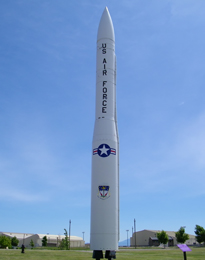Sentinel Costs - Planning - Technology

Sentinel Missile - Artist Concept
Digital Engineering And Modular Design
Transitioning into the research, development and production stages of the Sentinel missile finds the Air Force and Northrop Grumman, the principal contractor for the Sentinel missile program, at a significant advantage given the advances in technology over the years.
One key advantage to those involved in the research and development stages in the Sentinel program is utilizing model based engineering and digital engineering to design the Sentinel missile and weapon system overall. Using computers to explore any nuances or potential problems or glitches, be it structural, software driven, electrical or other areas allows these developers to catch unforeseen problems before they actually get to the production stage.
A significant amount of time, effort and money will be saved by utilizing these features.
This is a stark contrast compared to the early days of the Minuteman missile program, where research and development was still ongoing while they were constructing the Launch Facilities for the Minuteman. It was not uncommon for the contractors out in the field having to dismantle what had already been built, to modify the Launch Facility for the changes being made as development of the Minuteman and its weapon system was being built, on the fly, per se.
Another key feature the Air Force is incorporating with the Sentinel missile and its weapons system overall is establshing that the Air Force owns the technical features developed for the Sentinel missile and its system. In other words, instead of contracting with outside companies to maintain and upgrade the software, hardware and other aspects of the system, the Air Force is stepping forward in assuring that they own the software and hardware and don't have to ask others to maintain, troubleshoot or upgrade the equipment. This will allow the Air Force to be able to sustain and update the weapon system through its lifecycle, increasing its long-term capability and reducing program costs and risks.
Modular design will utilize these features, and allow for the Air Force to adapt and change as technologies evolve, as well as addressing new threats that might become prevalent. This will allow the Air Force to change certain features in the Sentinel missile and its weapons system, and not have to completely revamp the system. This will add to safety, security, and again provide more manageable costs.
The Air Force plans on collaborating with their AFWERX program. AFWERX is the innovation arm of the Department of the Air Force and is driven by the Air Force Research Laboratory (AFRL). AFWERX provides cutting edge American ingenuity in addressing the most pressing challenges of the Department of the Air Force.
AFWERX works closely on an international scale across academia, industry and government to develop technology, and is able to draw upon a vast amount of talent and intellect, in addressing whatever problems or tasks they are presented with.
It goes to say, it is better to work smarter, not necessarily harder.
Nunn-McCurdy Act
Just before the end of business day January 18, 2024, the Air Force notified Congress of a Nunn-McCurdy breach on the Sentinel program. The Nunn-McCurdy Act requires the Pentagon to inform lawmakers if a program incurs a cost or has a schedule overrun of more than 15 percent. Any breach over 15 percent is considered "significant," while any breach of over 30 percent is considered "critical."
In the semantics of any weapon system development, there is a feature interwoven into each of those system development programs called a Program Acquisition Unit Cost. A PAUC. The Sentinel missile's Program Acquisition Unit Cost, which accounts for development, construction and acquisition cost, has increased by 37 percent. Outlined by the guidelines of a Nunn-McCurdy breach, this is considered "critical."
One source states that when the Sentinel program was outlined in 2020, the PAUC was established at $118 million. The 37 percent increase now establishes this estimate at $162 million for the PAUC, per this source's report. Under the Nunn-McCurdy Act, any programs established as at a "critical" status are assumed to be headed for termination, unless the Secretary of Defense certifies that there are no other alternatives, as well as a number of factors that are addressed in this review.
At this juncture it will fall upon Defense Secretary Lloyd Austin to make that certification, based on a number of variables, such as the necessity of replacing the 50 year old Minuteman III missiles, the end of life these missiles pose, and that there are no other lower cost alternatives to the Sentinel missile and other factors.
Two sources address these significant increases in cost. One source states that the Air Force did not take into account the necessity to upgrade the copper cables used with the HICS, Hardened Intersite Cable System, with more advanced and higher performing fiber optic network. It is being posited that it was not taken into account the immense effort and costs in replacing the copper cables with fiber optics.
The difficulty with this issue is that the Air Force has been aware of the degradation of their copper cabling for years. Why would this not have been something previously established, and plans made based on this information?
At present the Air Force has stated the Pentagon is still studying what exactly caused the severe cost overruns, which triggered this review process related to the critical Nunn-McCurdy breach.
A second source highlights how the Government Accountability Office warned in June that ICBM-builder Northrop Grumman has been struggling with staffing shortfalls, supply chain problems, and clearance processing delays.
This second source states, 'The overruns aren't caused by the "missile itself," but by the program being a massive "civil works" project, including building the silos and missile field modernization.'
The Sentinel missile program is now being realized as the massive and complex new weapon system it truly is. The Sentinel missile and its weapon system is one of many top modernization efforts being managed by the Defense Department, and has a number of people rightuflly concerned.
Given the Minuteman III missile was initially planned to be used for 10 years and now the Air Force has been using this missile for 54 years, it is clearly time for Minuteman missile be replaced.
With the uncertainty of what is happening in Russia combined with the significant and concerning advancements being made in China with its ICBM weapon system, the importance of moving forward with the Sentinel missile and its program cannot be overstated. Some Defense Department experts are making coherent and sound arguments as to why the United States needs to move forward with a much needed modernized nuclear force. These experts are commenting that given the significant advances with other countries and their significant movements toward modernizing their weapon sysems, it apears that the Sentinel program is unlikely to be terminated.
Nunn-McCurdy Act Review Update
On July 8, 2024 Under Secretray of Defense Willilam LaPlante provided this update on his decision following the review of the Nunn-McCurdy Breech. The following are direct quotes from LaPlante's statements, and can be reviewed from the transrcipt of the Department Of Defenses press briefing on the Nunn-McCurdy decision.
To review the press briefing in its entirety, follow the link directly below
UNDER SECRETARY OF DEFENSE FOR ACQUISITION AND SUSTAINMENT WILLIAM A. LAPLANTE: "As many of you are aware, on January 18th of this year, the Air Force notified Congress that the Sentinel program exceeded its baseline cost projections, resulting in a critical Nunn-McCurdy breach. By statute, the program must be terminated unless the Under Secretary of Defense for Acquisition and Sustainment certifies to Congress that the program meets established criteria to continue.
These criteria are as follows: number one, the program is essential to national security; number two, there are no alternatives to the program that will provide acceptable capability to meet the joint requirements at less cost; number three, that new cost estimates have been determined by the CAPE Director to be reasonable; number four, the program is a higher priority than programs whose funding will be reduced to cover he increased cost of this program; and number five, the management structure is sufficient to control additional cost growth.
LaPlante goes on to state: "Over the past 120 days, I have led the department in executing our statutory responsibilities to conduct a comprehensive, unbiased review of the program to determine what factors led to this cost growth and whether to certify continuation of the program. Based on the results of the review, it is clear that a reasonably modified Sentinel program remains essential to US national security and is the best option to meet the needs of our warfighters.
As the milestone decision authority, today I am certifying that the Sentinel program meets the statutory criteria to continue, but it is important to note that this certification does not indicate business as usual. The program will be restructured to address the root causes of the breach and ensure an appropriate management structure is in place to control costs.
The total program acquisition costs for a reasonably modified program are estimated by the CAPE to be $140.9 billion, an increase of 81 percent compared estimates at the program's previous Milestone B decision in September of 2020. There are reasons for this cost growth, but there are also no excuses. We fully appreciate the magnitude of the cost, but we also understand the risks of not modernizing our nuclear forces and of not addressing the very real threats we confront.
Followed by William LaPlante's statements, the Assistant Secretary of the Air Force For Acquisition, Technology and Logistics Andrew Hunter made the following statements:
"Well thank you, Dr. LaPlante. This is Andrew Hunter. First, I'd like to thank you and your team and the assessment teams that you led for the comprehensive review of the Sentinel ICBM program.
The Air Force fully supports the decision to restructure the Sentinel program and is committed to restructuring in a manner that provides a robust nuclear deterrent into the future, promotes the most effective acquisition of this critical capability that controls cost, and delivers the weapons system on a schedule that ensures our ability to sustain the nuclear deterrent.
The department's leaders are acutely aware that we can and must do more to improve program management and oversight of this vital project. We do not take lightly the once in a generation responsibility to modernize the ground leg of the nuclear triad and are mindful of the scope and scale of this undertaking, which is unprecedented in contemporary times.
Over the coming months, we'll develop a comprehensive plan for how the Air Force will restructure the program, tackling the root causes of cost growth while prioritizing effective program management and oversight. We'll move quickly to mature the restructure options that you've directed, especially related to the command and launch segment, improving our systems engineering and adjusting the contract structure and execution to deliver this project.
Our goal is to ensure the long-term success and sustainability of the ICBM force as it continues to provide 24/7 strategic deterrence, standing ready to respond at a moment's notice as the most responsive leg of the nuclear triad. We'll do what it takes to sustain Minuteman III to meet these warfighter requirements in the interim.
While awaiting your decision, Dr. LaPlante, the Air Force has already taken proactive steps to address challenges within the Sentinel program and enhance its governance and oversight. Last fall, the Department of the Air Force established a Nuclear Oversight Committee, which is co-chaired by the most senior leaders of the Department of the Air Force. The Nuclear Oversight Committee is responsible for providing oversight of the Air Force's nuclear enterprise, including strategic bombers, land-based ICBMs, and nuclear command and control.
We also recently established a dedicated Program Executive Officer, or PEO, for ICBMs, and are in the process of elevating the commander of the Air Force Nuclear Weapons Center to a three-star general, currently it's a two-star general, to a three star general, and established the Nuclear Systems Center.
These actions are just three examples that demonstrate our dedication to bringing the critically important Sentinel program to full mission capability. Our team is committed and ready to execute your direction, and I look forward to being able to share more information with the group on this call on our plan as it takes shape.

